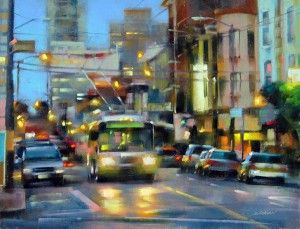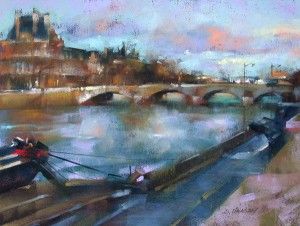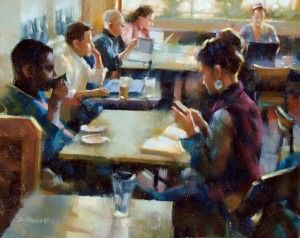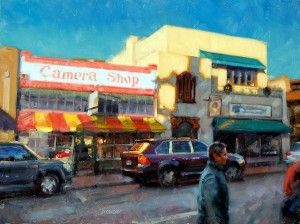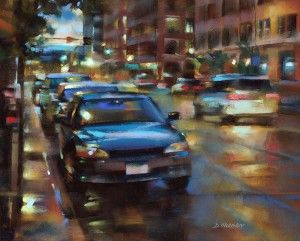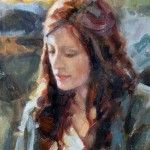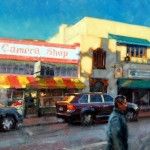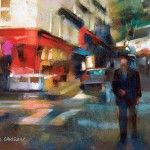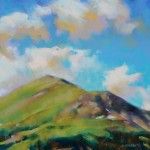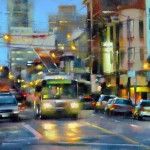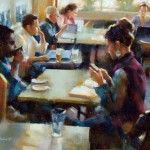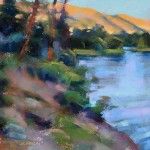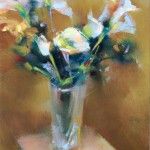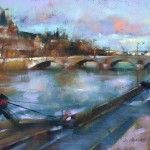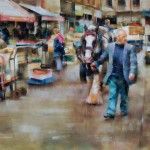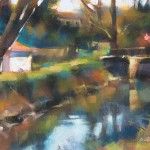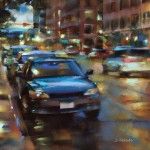Painter Desmond O’Hagan aims to immerse viewers into a scene
By Gussie Fauntleroy
This story was featured in the January 2013 issue of Southwest Art magazine. Order the Southwest Art January 2013 print edition, or download the Southwest Art January 2013 issue now…Or just subscribe to Southwest Art and never miss an issue!
Sunlight falling through windows onto the slope of shoulders, the tilt of heads bent in conversation, the curve of a hand around a mug or glass—these things are the same in an American coffee house or an Irish pub, which may be why Desmond O’Hagan finds himself so comfortable painting scenes in both locales. For many years—all his life, really—the 53-year-old Denver-based artist has returned periodically to Ireland, where both of his parents were born and raised. Even as a boy he would accompany his family as they socialized in local pubs, where a child could listen to gossip or passionate discussions or his uncle’s band playing traditional Irish tunes.
“The art of conversation is an important part of the culture there,” O’Hagan observes. “I have a large extended family in Ireland, and they enjoy talking—the TV’s not on; it’s just pure conversation. And painting is a way of communicating, of trying to express a story in color and shape.” His own preferred sources for visual tales are not only cafés and pubs but also sidewalks, street corners, and—especially at dusk—city streets themselves, where gathering dark meets the richly hued and constantly shifting dance of reflection and light.
All of O’Hagan’s life, it seems, circumstances have been arranging the necessary pieces of the jigsaw puzzle that eventually revealed itself as a career in fine art. It’s a career that has brought such honors as the Master Pastelist designation from the Pastel Society of America and, in 2005, induction into the Master Circle of the International Association of Pastel Societies. The artist’s award-winning paintings in both oils and pastels are in private and public collections around the country and abroad.
Go back one generation, and there’s the puzzle piece that spawned a love of travel, and with it, heightened observation skills and exposure to art museums in cities around Europe and the United States. O’Hagan’s father, intrigued by the sight of American planes over Northern Ireland during World War II, emigrated at 19 and joined the U.S. Air Force. He left the military long enough to return to Ireland, meet a Dublin woman, and marry her. After re-enlisting, he was stationed in Germany, where Desmond was born. Two years later the family was sent to Virginia, then to Alaska, and later to New Mexico.
During the early years of his own marriage, O’Hagan and his wife, who worked in the hotel industry at the time, had many opportunities for travel. They spent time in Paris, London, Edinburgh, Geneva, and Florence as well as Jamaica and major American cities—visiting art museums in each place. “Frequent travel definitely opened my eyes,” he says, his manner warm and confident as he looks back over his life.
Travel, of course, offers an inexhaustible source of material for O’Hagan’s art. His attention is especially drawn to scenes in which architectural elements provide a strong structural container for movement, color, and ever-shifting light. All of these components come together in works like SUNSET, SANTA FE, which features a man walking in partial shadow on a street, while strong sunlight illuminates the tops of the buildings behind him.
O’Hagan’s enchantment with color and light had its genesis in early experiences, including watching with awe the vast swirling flow of deep blues, greens, and purples as the aurora borealis performed across the northern night sky. Adding to his appreciation of rich, nuanced hues—and of the wild outdoors—were the dense forests surrounding the air force base in Alaska, where he spent part of his boyhood. But even more significantly, he now understands, were the years he lived in Albuquerque with his family and his years at the University of New Mexico. The celebrated, clear New Mexico light and its intensifying effects on color made an indelible impression on the way he sees.
As for the pull of art itself, O’Hagan has memories, going back to age 5, of wanting to draw whatever he saw. Endless pictures of Batman and Robin were followed by the top prize in an elementary school poster contest, which put young Desmond on the local news. In middle school his fascination with visual imagery gained an added boost from an unlikely source: a history teacher who drew detailed renderings of Civil War scenes on the blackboard in colored chalk. (The experience had the additional effect of sparking O’Hagan’s interest in history.)
All along, his parents encouraged and supported his love of art. “When I was a teenager, my parents said, Why not put on an art show? But as a kid, I couldn’t see how to do that,” he recalls. “For a while I thought I might go into science—my father went to work for Sandia National Laboratories after retiring from the air force. I took a lot of physics and chemistry courses, but art kept coming through.”
O’Hagan thought he would try architecture at UNM. He knew little about the field except that it promised to engage his deep-rooted love of structure, drawing, and design. It was not the right path. “I loved the design and creativity of architecture but not the nuts and bolts side of it. There was no real passion there,” he says. Yet even as he moved on, graduating instead from the Colorado Institute of Art in Denver (now the Art Institute of Colorado), there remained an underlying attraction to the lines and angles of buildings and the solidity of architectural forms. That resonance is reflected in the artist’s cityscapes, interior scenes, and even his landscapes, which often contain buildings. As he puts it, “I want something I can really get my teeth into, something with strong design.”
At school in Denver, O’Hagan found himself surrounded by others, both students and instructors, who shared his strong visual orientation and love of design. The experience reinforced his confidence and became a springboard into graphic design in the advertising field, still the only practical career he could envision in art. For three years he worked for a small ad agency in Denver while painting in his free time. Then German-American painter Pawel Kontny, known for his generous support of young Denver-area artists, offered to personally host a show of O’Hagan’s work. Half of O’Hagan’s paintings sold the first night. He credits his “fearless” wife—whom he married in 1984—with supporting his decision to pursue his own art full time in the mid-1980s.
During this period, O’Hagan began exploring the effects of pure pigment through the use of soft pastels. “With oils, I love the brush strokes and the way you can move the paint around,” he explains. “With pastels, even though they’re dry, you can achieve bold strokes, and the color can be explosive, and I love the texture. There can be variation and character in the strokes—it’s very versatile.”
Today O’Hagan spends about equal time working in pastels and oils in the spacious, art-book-lined studio he added, almost 20 years ago, to his home in Denver, where he has lived since 1994. His approach to both mediums involves a looseness of style and simplifying of forms, creating the effect of realism through implied detail. That which is implicit is effortlessly filled in by the viewer’s imagination and mind. EARLY EVENING ON THE SEINE, PARIS, for instance, depicts the river aglow with reflected sunset clouds as it flows beside the Louvre. Most of the venerable museum’s architectural elements, including its many windows, are minimally suggested, yet understood.
A similar effect is achieved in NORTH BEACH, SAN FRANCISCO, another pastel. A compelling vibrancy pulses through the image of parked and moving cars, repeating patterns in buildings and windows, and splashes of jewel-like color. “The energy of the city, with all this light and movement, has always held a fascination for me—people moving in all directions, many abstract shapes, streetlights and headlights reflecting,” O’Hagan says. “The most interesting challenge is to bring all this together in a representational image.”
In MIDDAY COFFEE (ST. MARK’S), the artist beautifully meets the challenge of transforming complexity into a clear expression of gesture, light, and mood, with multiple figures engaged in quiet activities in a coffee shop. Like the turn-of-the-20th century Russian, Spanish, and American painters he admires, O’Hagan invites viewers to slow down and appreciate the fleeting, ordinary moments of beauty too often rushed past. “I’m looking for things that turn your head, that grip you and make you excited to experience them,” he reflects. “Part of my goal is that, when I’m finished, I want you to feel like you’re actually there. Someone was looking at one of my paintings of a coffee shop and said, ‘Oh, I can smell the coffee!’ That’s when I knew it was a success.”
representation
Sugarman Peterson Gallery, Santa Fe, NM; E.S. Lawrence Gallery, Aspen, CO; RC2 at Rosenbaum Contemporary, Boca Raton, FL; www.desmondohagan.com.
Featured in the January 2013 issue of Southwest Art magazine–click below to purchase:
Southwest Art magazine January 2013 digital download
Southwest Art magazine January 2013 print edition
Or subscribe to Southwest Art magazine and never miss a story!
- Desmond O’Hagan, Young Woman, oil, 11 x 14.
- Desmond O’Hagan, Sunset, Santa Fe, oil, 36 x 48.
- Desmond O’Hagan, Southern France, pastel, 9 x 12.
- Desmond O’Hagan, North of Leadville, Colorado, pastel, 16 x 20.
- Desmond O’Hagan, North Beach, San Francisco, pastel, 18 x 24.
- Desmond O’Hagan, Midday Coffee, St. Marks, pastel, 16 x 20.
- Desmond O’Hagan, Lake Dillon #1, pastel, 11 x 14.
- Desmond O’Hagan, Floral Still Life, pastel, 9 x 12.
- Desmond O’Hagan, Early Evening on the Seine, Paris, pastel, 12 x 16.
- Desmond O’Hagan, Dublin Market, Ireland, pastel, 18 x 24.
- Desmond O’Hagan, Arles, France, pastel, 9 x 12.
- Desmond O’Hagan, 15th and Wazee, Denver, pastel, 16 x 20.
MORE RESOURCES FOR ART COLLECTORS & ENTHUSIASTS
• Subscribe to Southwest Art magazine
• Learn how to paint & how to draw with downloads, books, videos & more from North Light Shop
• Sign up for your Southwest Art email newsletter & download a FREE ebook






